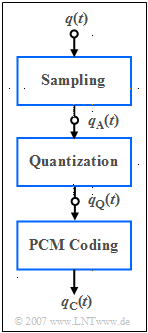Difference between revisions of "Aufgaben:Exercise 1.2Z: Puls Code Modulation"
From LNTwww
| Line 7: | Line 7: | ||
On the right you see the (simplified) block diagram of the PCM transmitter with three functional units: | On the right you see the (simplified) block diagram of the PCM transmitter with three functional units: | ||
*The band-limited speech signal ${q(t)}$ is sampled, where the [[Signal_Representation/Time_Discrete_Signal_Representation#Das_Abtasttheorem|Abtasttheorem]] is observed, and yields the sampled signal $q_{\rm A}(t)$. | *The band-limited speech signal ${q(t)}$ is sampled, where the [[Signal_Representation/Time_Discrete_Signal_Representation#Das_Abtasttheorem|Abtasttheorem]] is observed, and yields the sampled signal $q_{\rm A}(t)$. | ||
| − | * Each sample $q_{\rm A}(t)$ is mapped to one of $M = 2^N$ | + | * Each sample $q_{\rm A}(t)$ is mapped to one of $M = 2^N$ results in the quantized signal $q_{\rm Q}(t)$. |
* Each individual quantized value is represented by a code sequence of $N$ binary symbols and results in the coded signal $q_{\rm C}(t)$. | * Each individual quantized value is represented by a code sequence of $N$ binary symbols and results in the coded signal $q_{\rm C}(t)$. | ||
| Line 18: | Line 18: | ||
| − | ''Notes:'' This task belongs to the chapter [[Signal_Representation/Signal_classification| | + | ''Notes:'' This task belongs to the chapter [[Signal_Representation/Signal_classification|Signal classification]]. |
| Line 30: | Line 30: | ||
+ A deterministic source signal is only useful in test operation or for theoretical investigations. | + A deterministic source signal is only useful in test operation or for theoretical investigations. | ||
- ${q(t)}$ is a time-discrete signal. | - ${q(t)}$ is a time-discrete signal. | ||
| − | + ${q(t)}$ is a continuous | + | + ${q(t)}$ is a continuous-valued signal. |
| Line 54: | Line 54: | ||
+ $q_{\rm C}(t)$ is a binary signal. | + $q_{\rm C}(t)$ is a binary signal. | ||
- When sampling at distance $T_{\rm A}$ the bit duration is $T_{\rm B} = T_{\rm A}$. | - When sampling at distance $T_{\rm A}$ the bit duration is $T_{\rm B} = T_{\rm A}$. | ||
| − | + | + | + When sampling at distance $T_{\rm A}$ the bit duration is $T_{\rm B} = T_{\rm A}/8$. |
Revision as of 13:40, 25 December 2020
All modern communication systems are digital. The principle of digital transmission of speech signals goes back to Alec Reeves , who invented the so-called Pulscodemodulation (PCM) as early as 1938.
On the right you see the (simplified) block diagram of the PCM transmitter with three functional units:
- The band-limited speech signal ${q(t)}$ is sampled, where the Abtasttheorem is observed, and yields the sampled signal $q_{\rm A}(t)$.
- Each sample $q_{\rm A}(t)$ is mapped to one of $M = 2^N$ results in the quantized signal $q_{\rm Q}(t)$.
- Each individual quantized value is represented by a code sequence of $N$ binary symbols and results in the coded signal $q_{\rm C}(t)$.
In this task only the different signals of the PCM transmitter are to be classified. Later tasks will deal with other properties of pulse code modulation.
Notes: This task belongs to the chapter Signal classification.
Questions
Solution
(1) Correct are the solutions 1, 2 and 4:
- The source signal ${q(t)}$ is analog, i.e. time- and value-continuous.
- Im Allgemeinen macht es keinen Sinn, ein deterministisches Signal zu übertragen.
- Für die mathematische Beschreibung eignet sich ein deterministisches Quellensignal – wie zum Beispiel ein periodisches Signal – besser als ein Zufallssignal.
- Deterministische Signale werden auch für den Testbetrieb herangezogen, um erkannte Fehlfunktionen rekonstruieren zu können.
(2) Correct are the solution suggestions 2 and 3:
- The signal $q_{\rm A}(t)$ after sampling is still value-continuous, but now time-discrete.
- The sampling frequency $f_{\rm A}$ is given by the so-called sampling theorem .
- The greater the maximum frequency $f_{\rm N,\,max}$ of the message signal, the greater must $f_{\rm A} ≥ 2 \cdot f_{\rm N,\,max}$ can be selected.
(3) Correct are the solution suggestions 1 and 3:
- The quantized signal $q_{\rm Q}(t)$ is time and value discrete, where the number of steps are $M = 2^8 = 256$
- A binary signal, on the other hand, is a discrete value signal with the number of steps $M = 2$.
(4) Correct here are the solutions 1, 3 and 5:
- The coded signal $q_{\rm C}(t)$ is binary $($level number $M = 2)$ with bit duration $T_{\rm B} = T_{\rm A}/8$.
